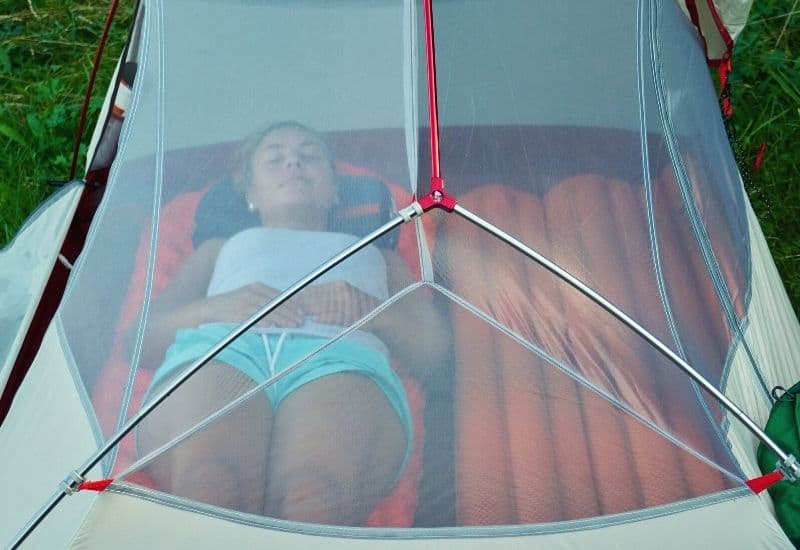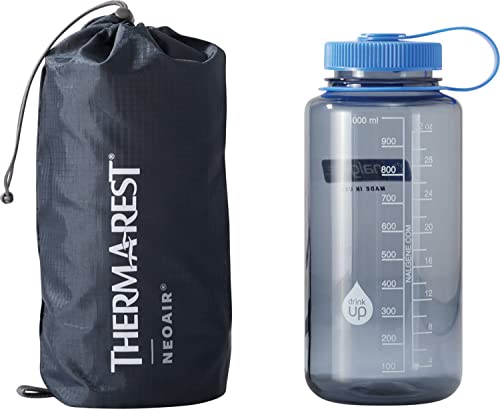A night under the stars can be a backpacker’s dream, but when the reality of hard, uneven terrain or cold ground disrupts sleep, it quickly turns into a nightmare. The quest for a sleeping pad that combines comfort, warmth, and portability is a. common one among outdoor enthusiasts. Balancing these key attributes is no easy feat, resulting in many sleepless nights even in the most beautiful natural settings.
To help you find the best sleeping mat for your backpacking adventures, we’ve created a list of our top sleeping pads of 2024 with the Neoair Xlite from Term-A-Rest found to be the best overall.
Other highly recommended contenders we review include the Therm-a-Rest NeoAir UberLite, NEMO Tensor Insulated, Therm-A-Rest NeoAir XTherm, NEMO Switchback, Klymit Static V2, Sea to Summit UltraLight Insulated, Big Agnes Insulated Q-Core SLX, Sea to Summit Comfort Plus Insulated, Big Agnes Insulated Air Core Ultra, and the Therm-a-Rest ProLite Plus.
We also explain what features to look for in a good sleeping pad, including the various types to choose from, R-Values, thickness & comfort, size & shape, weight & packed size, durability, inflation & deflation, as well as women’s-specific sleeping pads. Finally, we also discuss how to take care of your sleeping mat to ensure years of use.
Table of Contents
At A Glance: Sleeping Pad Quick Recommendations
-
Top Choice:
Therm-A-Rest NeoAir XLite NXT
“Great metrics across the board, the XLite is a premium pad that gets excellent scores for insulation, weight, packed size, and comfort” -
Runner Up:
NEMO Tensor Insulated
“Narrowly lost out to the XLite, but if you’re looking for a thicker mat with a little more cushion, and are happy to accept a few more ounces in your pack, then the Tensor is a solid pick.” -
Budget Pick:
Klymit Static V2
“A lightweight, durable and wide air pad with a remarkable price tag” -
Value Pick:
Big Agnes Insulated Air Core Ultra
“The Air Core Ultra comes close to matching the premium pads for comfort, insulation, and packed size at a much lower price” -
Top Self-Inflating Pad:
Therm-a-Rest ProLite Plus
“Therm-A-Rest’s classic & popular self-inflating pad got a new valve design in 2020 and in our opinion is still the best self-inflating sleeping pad on the market” -
Top Closed-Cell Foam:
NEMO Switchback
“Beating out its closest competitor, the Therm-a-Rest Z Lite Sol, the NEMO Switchback is the most packable, lightest, and most durable foam sleeping pad available” -
Top Ultralight:
Therm-a-Rest NeoAir UberLite
“8.8 oz and packs down to the size of a regular soda can. The UberLite goes ultralight without giving up on comfort” -
Top Winter Pad:
Therm-A-Rest NeoAir XTherm NXT
“When winter camping there is none that can match the NeoAir XTherm for its unbelievable warmth-to-weight ratio, clocking an R-Value of 6.9 while still weighing less than a pound” -
Best for Side Sleepers:
Big Agnes Insulated Q-Core SLX
“If you’re a side sleeper, then the 3.5” of cushion provided by the SLX’s I-beam baffle construction will have you sleeping comfortably throughout the night” -
Most comfortable:
Sea to Summit Comfort Plus Insulated
“With not one, but two layers of its airsprung cells™ the Comfort Plus is as luxurious as lightweight backpacking gets” -
Recommended:
Sea to Summit UltraLight Insulated
“A great option that comes with an affordable price tag, but has a bit of work to do to compete with the top pads available”
What are the best sleeping pads for backpacking?
We’ve tested sleeping pads on the trail, at home and in our yards over the last few years, and present to you our shortlist below of the best sleeping pads of 2024.
- Therm-A-Rest NeoAir XLite NXT
- Therm-a-Rest NeoAir UberLite
- NEMO Tensor Insulated
- Therm-A-Rest NeoAir XTherm
- NEMO Switchback
- Klymit Static V2
- Sea to Summit UltraLight Insulated
- Big Agnes Insulated Q-Core SLX
- Sea to Summit Comfort Plus Insulated
- Big Agnes Insulated Air Core Ultra
- Therm-a-Rest ProLite Plus
Therm-A-Rest NeoAir XLite NXT
Editors’ ChoiceCategory: Air • Shape: Mummy • R-Value: 4.5 • Weight (regular): 13 oz (369g) • Thickness: 2.5”
The Therm-a-Rest NeoAir Xlite wins our Best Backpacking Sleeping Pad award due to its excellent performance in every metric, from packability and weight to comfort and durability.
While the NeoAir Xlite is nearly 50% heavier than the Uberlite, it’s still the second lightest inflatable pad we tested at 13 oz (369g). This extra weight results in a higher R-value of 4.5, making it second only to the NeoAir Xtherm in terms of warmth-to-weight ratio.
It features the same baffled internal structure and 3” thickness you see on other inflatable Therm-a-Rest pads – all of them are extremely comfortable and support all the right areas.
While not the most durable pad on our list, the 30D rip HT nylon is a step up from the Uberlite and provides ample protection, as long as you are careful with clearing your sleeping area.
Therm-a-Rest pads is that they are noisy, and the NeoAir Xlite is probably the worst offender in their NeoAir line of products. The noise does diminish over time, but if you’re a light sleeper then be warned.
PROs
- Great Warmth-to-Weight
- Lightweight at only 12.5 oz
- Comfortable & supportive
- Great all-rounder
CONs
- Noise can be annoying
- Expensive
Bottom-Line: The Therm-a-Rest NeoAir Xlite NXT wins the best backpacking sleeping pad award thanks to high scores in every metrics.
Therm-A-Rest NeoAir UberLite
Best UltralightCategory: Air • Shape: Mummy • R-Value: 2.3 • Weight (regular): 8.8 oz (250g) • Thickness: 2.5″
The Therm-a-Rest NeoAir Uberlite earns our vote as the best ultralight sleeping pad for backpacking due to its featherlight weight and tiny packed size.
The Uberlite is the lightest sleeping pad we tested, weighing an insane 8.8 ounces (250g). Its packed size is similar to a soda can (3.6” x 6”), so it’s ideal for long backpacking trips.
Despite the tiny weight, the Uberlite is a comfortable sleeping pad thanks to its 2.5” thickness and the support offered by the horizontal baffle structure. It’s also easy to inflate with Therm-a-Rest’s new Winglock valve design and the included pump sack.
The reduced weight and size does come at a cost to warmth and durability. With an R-value of 2.3, this mat is best suited for summer adventures only. The fabric is also only 15D nylon, the thinnest we’ve encountered, something that had our testers taking extra care when setting up camp and moving around their tent.
PROs
- Ultralight at 8.8 ounces
- Tiny packed size
- Great comfort & support
- Quietest NeoAir model
CONs
- Not great in low temperatures
- Thin materials
Bottom-Line: If you need an ultra-lightweight sleeping pad for some summer backpacking, then the 8.8-ounce Therm-a-Rest NeoAir Uberlite is our top pick.
NEMO Tensor Insulated
Runner UpCategory: Air • Shape: Mummy/Rectangular • R-Value: 3.5 • Weight (regular): 1 lb 1 oz (490g) • Packed vol: 0.9 liters • Thickness: 3”
The NEMO Tensor sleeping pad was a strong contender for the best inflatable sleeping pad award and is a great pick if you’re looking for a thicker, cheaper, and quieter option than the Xlite.
The Tensor is 3” thick, making it one of the thicker pads we tested. This helps provide more comfort and prevent contact with the floor, particularly for side sleepers. Despite the thicker cushioning, it weighs just 1 lb 1 ounce and has a tiny packed size of 0.9 liters.
While heavier than the NeoAir Xlite (4 ounces lighter) and the NeoAir Uberlite (9 ounces lighter), the Tensor is “lightweight”.
The Tensor has the best valve/pump sack setup we tested. The Vortex™ pump sack easily connects to the Laylow™ zero-profile valve and will quickly inflate.
To help reduce the weight, yet provide the extra thickness, NEMO has chosen to go with a 20D PU polyester fabric which means it’s not as durable as most of the other pads we tested.
Like all NEMO Sleeping pads, this one comes with a great repair kit and a lifetime warranty.
PROs
- Small pack size & lightweight (490g)
- Thick (3”) and comfortable
- Easy to set up with Vortex™ pump sack
- Reasonable price for a top-end model
- Quiet
CONs
- Thinner more delicate material
- Heavier than Xlite
- Not as warm as Xlite
Bottom-Line: If you’re a side sleeper or want a little more cushioning and comfort, then the NEMO Tensor is a great cheaper alternative to our top pick, the Therm-a-Rest NeoAir Xlite.
Therm-A-Rest NeoAir XTherm NXT
Best Warmth-To-WeightCategory: Air • Shape: Mummy • R-Value: 7.3 • Weight (regular): 16 oz (430g) • Thickness: 3”
The Therm-a-Rest NeoAir Xtherm NXT is the best backpacking sleeping mat in the business if you’re a cold sleeper, are heading to colder climates, or just want the highest r-value sleeping pad available.
The ThermaCapture™ reflective lining and the Triangular Core Matrix™ construction give Xtherm achieve a lofty 7.3 R-value – the highest we tested. Despite this, it weighs just 15 ounces. This makes the Xtherm lighter than our runner-up, the NEMO Tensor, but with more than double the R-value.
Our testers were impressed by the XTherm’s rugged construction. It uses a 70D Nylon base with a 30D ripstop nylon top, making it one of the more durable pads around.
This 4-season sleeping pad packs down to a reasonable 9” x 4”, which beats out many of the 2- and 3-season pads we tested.
It comprises the same insulated baffle and horizontal cell design as its contemporaries in the NeoAir line. All of these pads pack 3” of thickness and are comfortable sleeping pads. However, like the Xlite and Uberlite, the Xtherm NXT does suffer from being noisy.
The biggest drawback to the XTherm is that for most trips the R-value is overkill, and for most backpackers, you can find a more suitable (3-season) pad for a cheaper price.
PROs
- Incredible Warmth-to-Weight ratio
- Great weight & packed size for a 4-season pad
- 70D bottom material adds durability
CONs
- Overkill for most trips
- Price
Bottom-Line: The perfect pick for campers and backpackers Backpackers looking for a great winter sleeping pad with a virtually peerless warmth-to-weight ratio.
NEMO Switchback
Best Closed Cell Foam PadCategory: Closed Cell Foam • Shape: Rectangular • R-Value: 2 • Weight (regular): 10.5 oz (300g) • Thickness: 0.9”
The NEMO Switchback is a popular sleeping pad with backpackers everywhere due to its simplicity, featherlight weight, and tough construction.
The Switchback comprises closed-cell foam with a thermal reflective film to bring the R-Value up to a respectable value of 2. A just 0.9” thick, it’s not the most comfortable of pads despite its dual foam density design, but if you’re after a foam pad, comfort is not your most pressing concern.
The Switchback weighs 10.5 ounces (300g) and packs down to 20” x 5” x 4”, making it more suitable to attach to the outside of the pack. This makes it substantially smaller than its nearest competitor, the Therm-a-Rest Z-lite Sol (which didn’t make our list), despite being thicker. We found it to hold up to wear and tear on the trail better too.
The downsides of the Switchback are common to all foam pads — they simply can’t compete with inflatable pads for comfort and it is only suited for summer trips.
PROs
- Great, affordable price
- Durable
- Easy to Use
- Can be used as a camp sit pad
CONs
- Not very comfortable
- Summer use only (as a primary pad)
- Large pack size means it needs to be strapped to your pack
Bottom-Line: The NEMO Switchback is our pick for the best foam sleeping pad and a great option if you prefer to travel fast and light.
Klymit Static V2
Best BudgetCategory: Air • Shape: Rectangular • R-Value: 1.3 • Weight (regular): 1 lb (454g) • Thickness: 2.5”
The Klymit Static V2 is our favorite cheap sleeping pad for backpacking – it’s not a star performer in any metric, but it is one of the best sleeping pads we’ve come across at such a low price point.
The Static V2 weighs just 1 lb (454g) and packs down to 3” x 8”. It only has an R-value of 1.3, so we’d only recommend it for summer camping. (For more insulation, check out the Insulated Static V).
Comfort-wise, the unique V-shape baffles and 2.5” thick air chambers do a decent job of supporting your body, particularly at the key pressure points around the shoulders and hips.
The V-shape baffles, while unique, are not as comfortable as the horizontal baffles found on the NeoAir line and the difference in thickness can be felt as compared to the NEMO Tensor or the Big Agnes Q-Core SLX. If you’re a side sleeper, then the baffles may not keep you from bottoming out.
The pad’s outer fabric is made from 30D/75D polyester (top/bottom respectively) and after some testing (including by our resident 3-year-old backpacker in training) we found it to be the most durable air pad to make our shortlist.
PROs
- Great value
- Wider than most regular pads
- Durable air pad
CONs
- Low R-value
- Older valve design
- Can bottom out when moving
Bottom-Line: If you need a cheap and durable pad for the occasional backpacking or car camping trip during the summer, then the Klymit Static V2 is a great budget-friendly option.
Sea To Summit UltraLight Insulated
RecommendedCategory: Air • Shape: Mummy • R-Value: 3.1 • Weight (regular): 1 lb 0.9 oz (480g) • Thickness: 2”
The Sea to Summit Ultralight Insulated is one of the most comfortable sleeping pads on the market and a great pick for three-season backpacking.
The 2 ” thick cushioning provided by the single layer of airsprung cells™ provides great comfort for the weight and despite the apparent lack of thickness (the NeoAir line are 2.5” thick and Big Agnes’s sleeping pads are over 3.25” thick).
It weighs in at a respectable 1 lb 1 oz, sticking it firmly in the middle of the pack, but has a bulkier packed volume of 3.1 L making it the largest (packed) inflatable option on our list.
With a 3.1 R-Value, it’s on the cusp of being suitable for shoulder season trips, however, we’d recommend a warmer model if you sleep cold and are expecting chillier spring or fall nights.
Overall, the Sea to Summit Ultralight Insulated is a respectable offering but there are better options available if you are willing to part with a little bit more cash e.g. the RRP of the NEMO Tensor is only marginally higher but is a much better option all around.
PROs
- Very comfortable
- One of the more durable pads
- Good valve system
- Affordable
CONs
- Not a stand out in any category
- Large packed size
Bottom-Line: The Sea to Summit Ultralight Insulated is a thin with a lower price point compared to other premium air pads.
Big Agnes Insulated Q-Core SLX
Best For Side SleepersCategory: Air • Shape: Rectangular • R-Value: 3.2 • Weight (regular): 1 lb 2 oz (510g) • Thickness: 3.5” (4.25” rails)
The Big Agnes Insulated Q-Core SLX is the perfect sleeping pad for side sleepers thanks to its chunky dimensions and cradling design.
Measuring 3.5 “ thick with 4.25 “ side rails, the offset I-Beam construction of this inflatable sleeping pad provides sufficient cushion to keep even the heaviest of side sleepers happy.
As with the Sea to Summit Ultralight Insulated, the SLX has a respectable 3.2 R-Value, making it ideal for summer and the odd 3-season adventure. The Q-Core SLX does come in a Deluxe version, which has an improved 4.3 R-value, but will add an extra 7 ounces to your backpack.
At 1 lb 2 ounces, this isn’t the lightest sleeping pad out there, and combined with an R-Value of 3.2, this means it’s one of the poorer warmth-to-weight inflatable sleeping pads we tested.
Our testers loved the variety of sizes this pad is available in. There are three different lengths on offer (66”, 72” or 27”) and widths (20”, 25” or 40”) — the widest of which is into double pad territory for couples.
PROs
- Thick and comfortable
- Rails help keep you centered
- Available in multiple sizes
- Good packed size
CONs
- Lower Warmth-to-Weight
- Middle of the road weight
Bottom-Line: Thanks to its thick sleeping platform, the Big Agnes Insulated Q-Core SLX was one of the most comfortable sleeping mats, and the best sleeping pad for side sleepers, in our tests.
Sea To Summit Comfort Plus Insulated
Most ComfortableCategory: Air • Shape: Mummy • R-Value: 4 • Weight (regular): 1 lb 13.8 oz (854g) • Thickness: 2.5” inches thick • Packed Volume: 2.9 liters
Our testers unanimously voted the Sea to Summit Comfort Plus Insulated the most comfortable sleeping pad out there owing to its cushy two-layer insulation.
The 2.5” thick sleeping platform is not the thickest we tested, but the two separate layers of airsprung cells™ take sleeping pad comfort to a whole other level.
You do pay a weight penalty for this extra comfort with it weighing 1 lb 13.8 ounces, making it 13 ounces heavier than the S2S Ultralight Insulated. However, the extra weight means extra insulation, and the Comfort Plus insulated has a respectable R-Value of 4. However, when looking at warmth-to-weight, this does mean it’s one of the poorer performing pads on our list.
It also has the largest pack volume (at 2.9 liters), making it nearly double the size of the Big Agnes Insulated Q-Core SLX which has similar levels of comfort.
PROs
- Very comfortable
- Quieter than the competition
- Warm pad
- Stable & supportive
CONs
- Heavy
- Price
Bottom-Line: Thanks to its two separate layers of airsprung cells™ the Sea to Summit Comfort Plus Insulated tops our list for sleeping pad comfort.
Big Agnes Insulated Air Core Ultra
Best ValueCategory: Air • Shape: Rectangular • R-Value: 4.5 • Weight (regular): 1 lb 6 oz (626g) • Thickness: 3.25” (3.5” rails) • Pack Volume: 1.6 liters
The Big Agnes Insulated Air Core Ultra is a great backpacking sleeping mat at a reasonable price. It’s lightweight, has a good R-value for three-season backpacking and camping, and costs around half the price of premium models.
Whilst not as thick as the SLX at 3.25 “ (3.5 “ on the side rails), our testers found its I-beam baffle construction offers a stable and comfortable sleeping platform. Combine that with a 4.5 R-value and you’ve got a comfortable and warm pad that will see you through most of the year.
Like all Big Agnes pads, the Air Core Ultra comes in 3 different lengths and 3 different widths, making it easy to find the right sleeping pad dimensions to suit your body and your sleeping style.
At a weight of 1 lb 6 oz, it’s heavier than its competitors (bar the Comfort Plus) but does pack down to a reasonable 1.6 liters pack volume.
PROs
- Very affordable
- Good thickness and side rails
- Great R-value
- Packs small
- Variety of size options
CONs
- Heavy
- Vertical baffles not as comfortable as box/horizontal ones
Bottom-Line: If you don’t have the budget for one of the premium pads, then the Big Agnes Air Core Ultra is a comfortable and warm option that won’t break the bank.
Therm-A-Rest ProLite Plus
Best Self-Inflating Sleeping PadCategory: Self-Inflating (hybrid) • Shape: Mummy • R-Value: 3.2 • Weight (regular): 1 lb (454g) • Thickness: 1.5”
The Therm-a-Rest ProLite Plus is the perfect sleeping pad for backpackers who want optimal convenience, comfort, and reliability.
The ProLite Plus has an R-Value of 3.2 making it a good choice for all but the chilliest of shoulder-season camping. At 16 ounces, it is one of the lightest self-inflating pads available.
For those wanting a little more reliability than an air pad, but more comfort than foam can offer, our testees. The ProLite Plus uses 50D mini-hex ripstop polyester, making it one of the most durable on the list. And even if you get a puncture, the 1.5” of diagonal cut foam will ensure you’re never sleeping on the floor.
Therm-a-Rest’s classic and popular self-inflating design was recently updated with the addition of their new Winglock valve technology making it even easier to find the right firmness by adding/removing air.
The downside to owning a self-inflating pad is the trade-off you’ll make with packed size. At 6.5 liters when packed, it’s going to take up a lot of room in your backpack and is not that much smaller than the foam NEMO Switchback.
PROs
- Price
- Self-inflating
- Durability
CONs
- Thickness
- weight & packed size
Bottom-Line: If you need durability but want more comfort than foam, the classic Therm-a-Rest ProLite Plus is the best self-inflating pad on the market.
Sleeping Pad Reviews Comparison Table
| Product Name | Category | Shape | R-Value | Weight | Thickness |
|---|---|---|---|---|---|
| Therm-A-Rest NeoAir XLite NXT | Air | Mummy | 4.5 | 13 oz (369g) | 2.5” |
| Therm-A-Rest NeoAir UberLite | Air | Mummy | 2.3 | 8.8 oz (250g) | 2.5″ |
| NEMO Tensor Insulated | Air | Mummy/Rectangular | 3.5 | 1 lb 1 oz (490g) | 3” |
| Therm-A-Rest NeoAir XTherm NXT | Air | Mummy | 7.3 | 16 oz (430g) | 3” |
| NEMO Switchback | Closed Cell Foam | Rectangular | 2 | 10.5 oz (300g) | 0.9” |
| Klymit Static V2 | Air | Rectangular | 1.3 | 1 lb (454g) | 2.5” |
| Sea To Summit UltraLight Insulated | Air | Mummy | 3.1 | 1 lb 0.9 oz (480g) | 2” |
| Big Agnes Insulated Q-Core SLX | Air | Rectangular | 3.2 | 1 lb 2 oz (510g) | 3.5” (4.25” rails) |
| Sea To Summit Comfort Plus Insulated | Air | Mummy | 4 | 1 lb 13.8 oz (854g) | 2.5” |
| Big Agnes Insulated Air Core Ultra | Air | Rectangular | 4.5 | 1 lb 6 oz (626g) | 3.25” (3.5” rails) |
| Therm-A-Rest ProLite Plus | Self-Inflating (hybrid) | Mummy | 3.2 | 1 lb (454g) | 1.5” |
How To Choose A Sleeping Pad For Backpacking?
When choosing a new backpacking sleeping mat we suggest you consider the following features in the list below.
- Type of Sleeping Pad
- R-Value
- Thickness and Comfort
- Size and Shape
- Weight & Packed Size
- Durability (Denier)
- Inflation and Deflation
Type Of Sleeping Pad
When choosing a backpacking sleeping pad, you’ll have three options – air pads, self-inflating pads, and closed-cell foam pads.
Air Pads
Air pads work like inflatable mattresses but are refined to suit the demands of life on the trail. They are lightweight, easy to inflate and deflate, and durable enough for long backpacking trips. For these reasons, air sleeping pads are one of the most popular choices for backpackers.
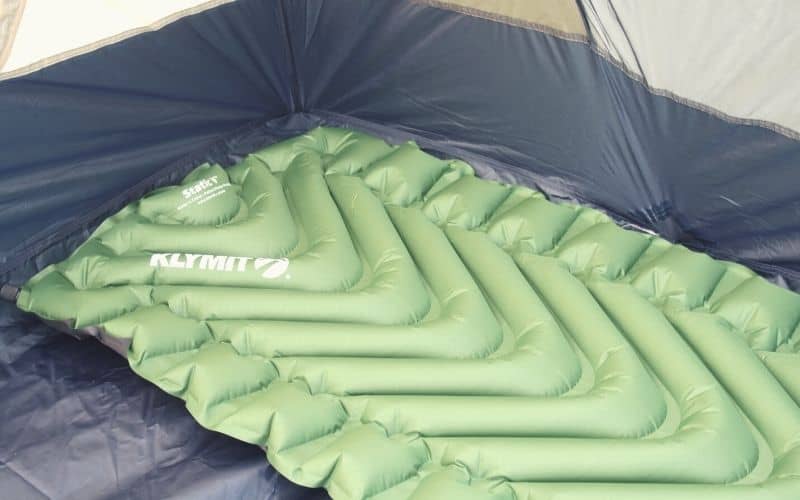
Air Pads Pros:
- Lightweight: Inflatable sleeping pads are often between 1/2 to 1 pound in weight
- Packed Size: Packing down to the size of a nalgene bottle (or smaller) is the norm, making it easy to store them in your backpack
- Comfort: Provide the most thickness, and the firmness can be customized by releasing or adding air
Air Pads Cons:
- Overnight Deflation: Slow punctures and poor valve design can cause air loss overnight.
- Noise: Certain pads/brands are worse than others, but movement can result in an annoying crinkly/crackly noise.
- Expensive: Most air pads are upwards of $150 or more.
- Durability: Sharp sticks and rocks could lead to punctures.
- Mold: Using lung power to inflate your pad introduces moisture from your breath, which can degrade performance or result in mold issues.
Self-Inflating Sleeping Pads
Self-inflating sleeping pads use a combination of open-cell foam and space for the pad to inflate with air. For backpackers looking for a combination of durability and comfort, then self-inflating pads are the way to go thanks to their puncture-resistant design and combination of air and foam insulation.
Self-Inflating Pad Pros:
- Durability: Self-inflating pads are more puncture-resistant and offer some padding if it deflates
- Insulation: Thanks to the combination of closed-cell foam and air, they have R-values suitable for 3-season backpacking
- Comfort: Not as comfortable as an inflatable pad, but thanks to the closed foam, more comfortable than a deflated inflatable pad.
Self-Inflating Pad Cons:
- Packed Size & Weight: The foam adds weight and bulk, making them heavier and bigger than air pads when packed down
- Thickness: Side-sleepers may not find them the most comfortable as they are thinner than air pads
Closed Cell-Foam Pads
Closed-cell foam sleeping pads are made of closed foam cells. Closed-cell foam pads are a popular choice for thru-hikers because of their versatility, light weight,and puncture-proof design.
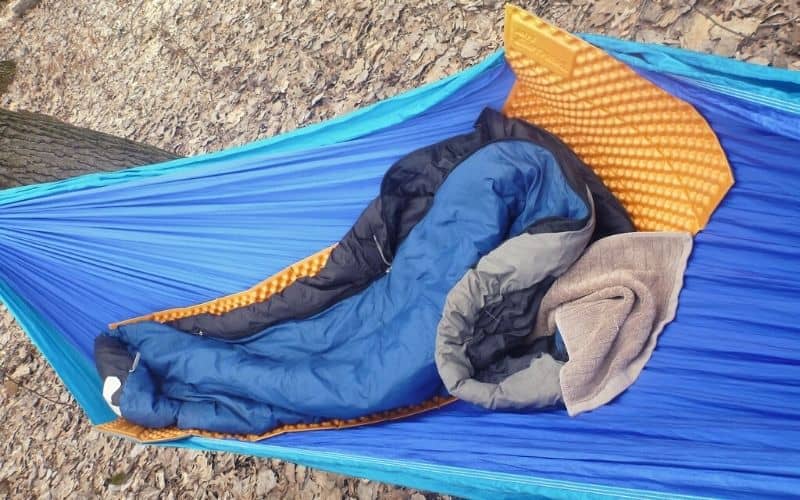
Closed Cell Foam Pros:
- Durability: Closed-cell foam is puncture-resistant, durable, and weatherproof
- Lightweight: Normal to weigh less than a pound, and even less if you opt for one that only covers your torso
Closed Cell Foam Cons:
- Comfort: The least comfortable option of the three due to their “rigidness” and lack of thickness
- Insulation: Thinner, with less insulation, closed-cell foam pads have low R-values making them only suitable as your primary pad for a summer backpacking trip
- Packed Size: These pads fold down, rather than pack and have the largest packed size. As a result, it’s necessary to strap them to the outside of your pack.
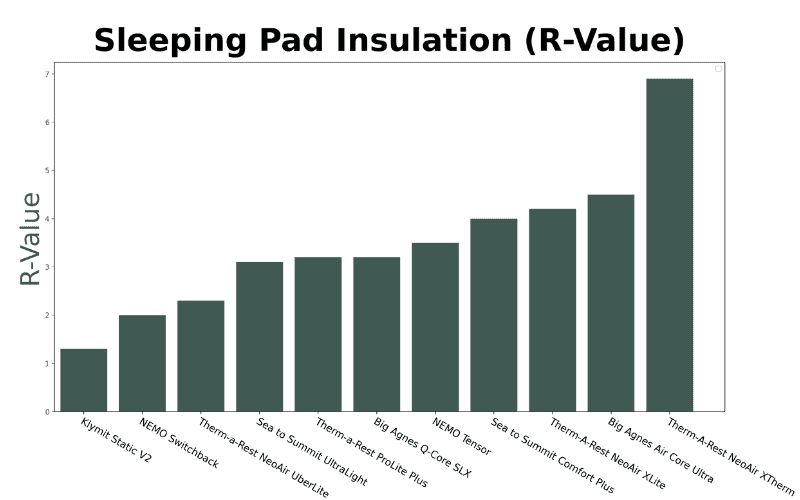
R-Value
When choosing a sleeping pad for backpacking, the r-value should be a top priority because this tells you how well the pad insulates.
The primary function of a sleeping pad is to provide a layer of insulation between your body and the cold ground. When combined with your sleeping bag, this should keep you warm through the night. Sleeping pad R-values are the industry’s measure of how much insulation a pad provides, and should be considered together with the comfort rating of your sleeping bag.
The higher the R-Value number, the more insulation the pad will provide against the cold. In our sleeping pad reviews, the tested models range from the Klymit V2 with an R-value of 1.3 (suitable only for warm-weather backpacking), to the Therm-a-Rest NeoAir Xtherm NXT with an impressive 7.3 R-value rating.
Why is a sleeping bag on its own not enough? A warm sleeping bag loses much of its effectiveness as the bottom insulation is compressed under you by your body weight. This compression reduces the loft and with it your bag’s ability to stay warm on the underside.
Unlike the EN ratings for sleeping bags, R-values don’t instantly “translate” into a temperature but we would recommend the following values:
- Summer backpacking: 1 to 3
- 3-Season sleeping pad: 3 to 5
- Cold weather camping in snow: 5+
The values above are a rough rule of thumb and should be used in combination with sleeping bags rated for the worst weather conditions you expect to face. If you are a cold sleeper then we recommend you get a pad with a higher r-value.
R-values can be“stacked” i.e. placing multiple pads on top of each other is the equivalent of adding their R-values together. If you go backpacking all year, rather than buying an expensive pad for each season, you can opt for a good 3-season option and purchase a cheaper pad to slip underneath.
Always prioritize warmth over weight, and select a pad that will do its primary function well.
Warmth-to-weight ratio is all-important as it indicates how efficient a pad is at keeping you warm for its overall weight. The overall leader in this category is the Therm-a-Rest NeoAir Xtherm, which has an R-Value of 7.3 and yet only weighs 16 ounces.
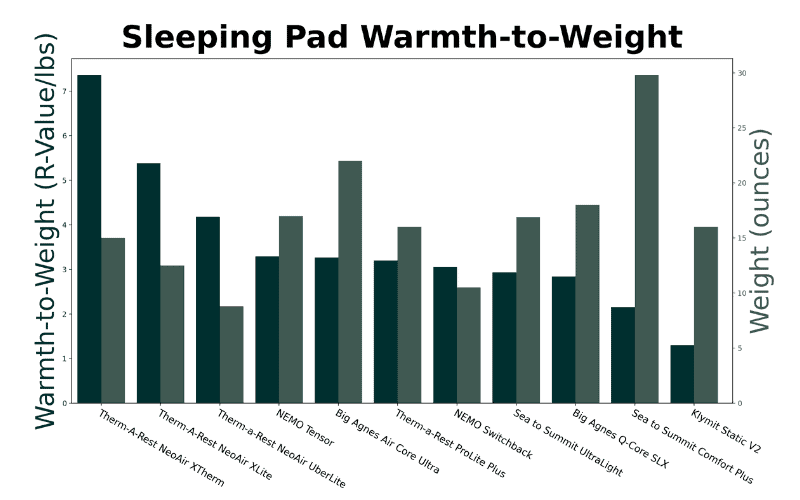
Thickness And Comfort
Thickness and comfort are also important considerations when choosing a new sleeping pad. There is, however, a balance to be struck against weight.
It’s important to find a pad that is thick enough to suit your sleeping style without “bottoming out” (coming into contact with the ground through the pad). Your hips and shoulders are the biggest pressure points, and selecting a pad that is too thin may result in an uncomfortable and sleepless night.
This is particularly true for side sleepers, as side sleeping puts more weight around the hips and shoulders, whereas back sleeping more evenly distributes your weight across the pad. If you sleep on your side, consider a thicker option to ensure a good night’s sleep.
Sleeping pads range from around an inch up to 3.5 inches in thickness, with air pads the thickest of the bunch. The Big Agnes Insulated Q-Core SLX is the thickest model we tested at 3.5″, making it a great option for side-sleepers. Although thinner at 2.5″, we found the Sea to Summit Comfort Plus Insulated provided excellent levels of comfort thanks to its two layers of air-sprung cells.
Another consideration if you are a light sleeper, or shift about a lot during the night is that air pads will make some noise. Some models such as the Therm-a-Rest NeoAir Xlite are particularly noisy, although the noise will reduce over time as the materials “wear in”.
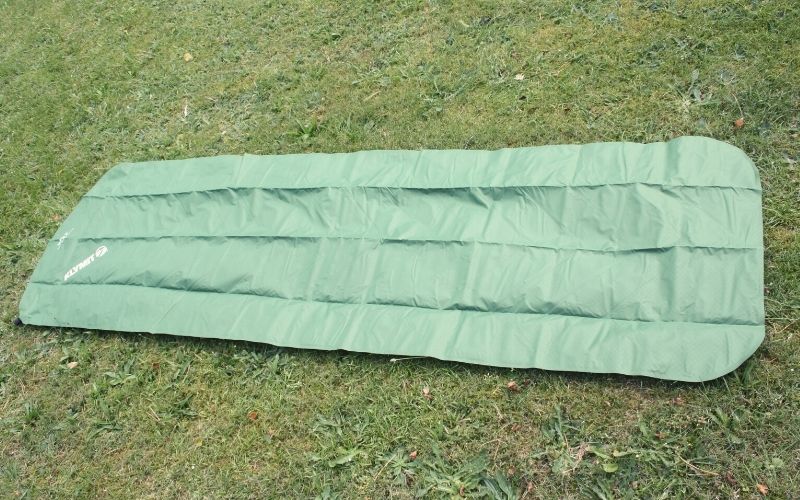
Size And Shape
The size and shape of your pad is well worth considering when choosing. The required dimensions will largely be determined by your height and weight — although there are some exceptions given below. Most sleeping pad models are available in two or three sizes:
- Small: Typically 66″ long and 20 to 25 inches wide.
- Regular: can be anywhere from 72 to 80 inches long and 20 to 25 inches wide.
- Large: 77-80 inches long and 25 inches wide.
Knowing your height will help you select the right length of pad, but when it comes to the width it will come down to your sleep style and how restless you are. Back sleepers prefer a wider option to help keep their arms from sliding off. If you shift a lot in your sleep then a wider pad, particularly one that has rails (slightly thicker outer beams), will help keep you off the ground during the night.
Also available are torso sleeping pads that are around half the length of regular pads. These pads only cover your upper body so are less comfortable than full-length ones. The major benefit is the weight reduction of your sleep system.
Double sleeping pads are available for couples — many of the Big Agnes models come in a doublewide option (40″ wide). However, these pads are heavy to carry and have a large packed size. As a result, many couples prefer to bring two sleeping pads as it allows each pad to suit its sleeper and lets you split the carried weight
Backpacking pads come in two different shapes — rectangular pads and mummy pads. Rectangular pads are more spacious and comfortable. Mummy pads taper towards the feet to cut weight. Again, we’d recommend side-sleepers opt for the rectangular pad.
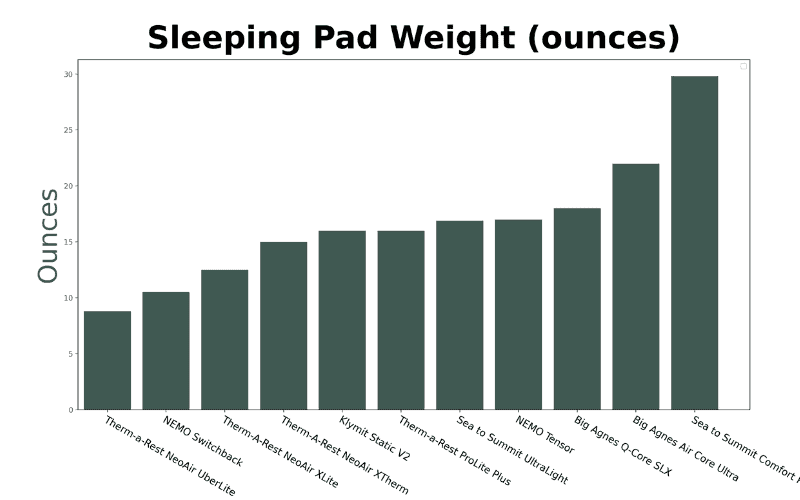
Weight & Packed Size
The weight and packed size of your sleeping pad is crucial consideration, especially if you plan on putting in the miles on the trails.
Before rushing out to buy the lightest model available, we’d caution you to consider your nighttime comfort as well. A few more ounces on your back during the day may well be worth the weight if it ensures you get a restful night’s sleep.
The backpacking sleeping pads we tested range from the lightweight Therm-a-Rest NeoAir Uberlite at 8.8 oz up to the heavy (but comfortable) Sea to Summit Comfort Plus Insulated, weighing in at nearly 40 ounces. However, most sleeping pads sit in the 12 – 18 ounce range. This includes our overall winner, the Therm-a-Rest NeoAir XLite (13 ounces).
While weight gets most of the attention, don’t overlook the sleeping pads packed size (or volume). The packed size will depend on the type of insulation, fabric thickness, and type of pad.
Lightly insulated air pads are the most compact, with some capable of compressing down to the size of a soda can. This makes air pads a great choice for ultralighters looking to save weight and packing space.
Self-inflating or closed-cell foam pads have larger packed sizes. Most closed-cell sleeping pads will need to be strapped to the outside of your pack.
Self-inflating sleeping pads have similar issues but constantly improving designs mean some like the Therm-a-Rest ProLite Plus are still compact enough to slip into a backpack.
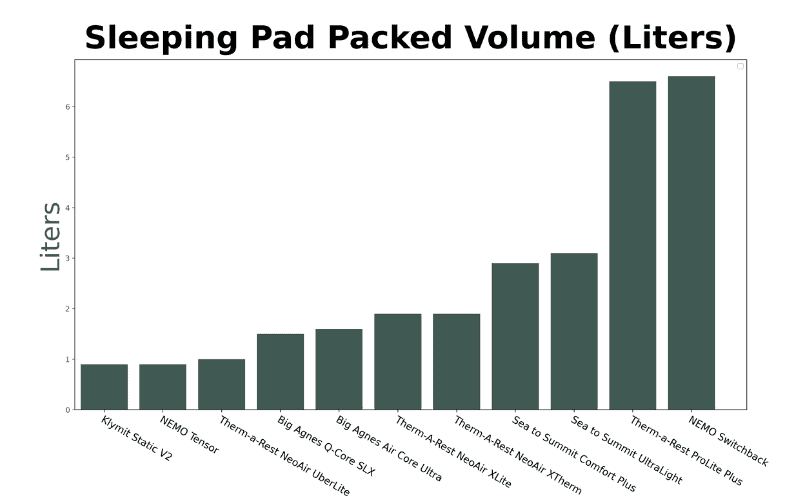
Durability (Denier)
Denier is the most common measure of durability in the outdoor gear world, so is another important consideration when choosing your pad.
The denier of fabric is a measure of the weight of the individual fibers, with higher deniers representing heavier weights. A reasonable rule of thumb is that higher denier equals a more durable fabric.
Finding the perfect balance between weight and durability is crucial.
Lower-denier fabrics are more prone to durability issues. So, if you plan to choose an ultralight low denier option, you will need a greater understanding of how to care for and repair your gear in the field.
Our top pick as the best ultralight sleeping pad, the Therm-a-Rest NeoAir Uberlite achieves its low weight by using 15D nylon. Our budget pick, the Klymit V2 is also our most durable, with a 75D polyester fabric used for the bottom layer.
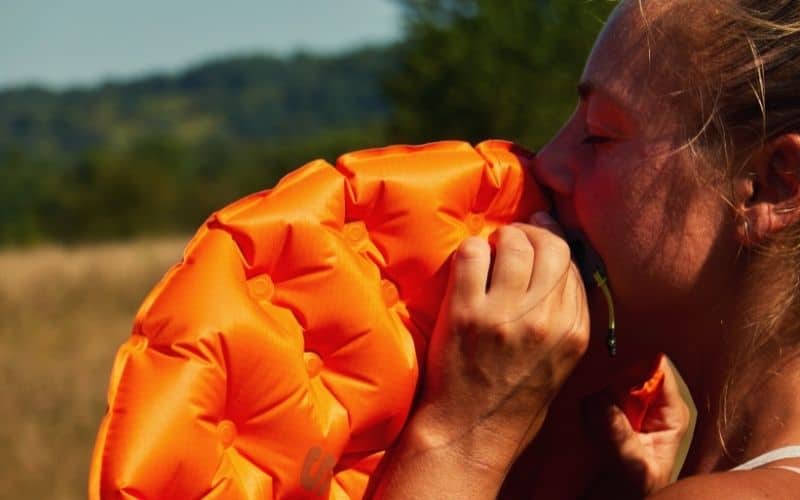
Inflation And Deflation
How easy it is to inflate and deflate your sleeping pad is a key consideration when choosing.
Traditional sleeping pad valves open and close by twisting and pushing a plastic valve on the mat. These are inefficient as the valve is completely open while inflating, which makes it easier for air to escape in between breaths. They also take some time to deflate and their upright profile takes up pack space.
Newer designs use flat valves to address this issue. Flat valves have a slimmer profile, making them easier to pack. This valve design has two dedicated openings, one for inflation and one for deflation. This is coupled with a flap that maximizes air retention during pumping.
Our testers love Therm-a-Rest’s WingLock valve™. This valve offers one-way inflation with no air loss between breaths, although we find it’s not as fast to inflate as a flat valve. To deflate the pad you turn both the cap and the cap “wings”. It’s a great sturdy design and is replaceable if it breaks.
While you can inflate your pad using lung power, it’s much simpler to inflate with pump sacks. Many pump sacks are now manufactured to double up as a stuff sack, and some can be used as a dry bag.
Not only will a pump sack give your lungs some respite, but it also helps prevent moisture (from your breath) from getting into the pad. This is important for two reasons:
- Adding moisture can result in bacteria or mold growing inside your pad.
- During winter trips where moisture will reduce R-Value.
Women’s-Specific Sleeping Pads
While women can use unisex sleeping pads, several manufacturers have gone one step further and offer female-specific sleeping pads. These pads offer several improvements for female backpackers.
- Shorter: A shorter length helps to reduce unneeded extra weight
- Improved comfort: Adjusted the foam design around the hips to provide greater comfort at one of the main contact points
- Improved Warmth: Women are known to sleep cold compared to men — which is why female versions may offer improved R-value compared to the unisex version
How To Care For Backpacking Sleeping Mats?
Sleeping pads are delicate pieces of backpacking gear, but with proper care and repair, they can last a long time.
When you return from the trail, always unroll a self-inflating pad and open the valve. If it is stored compressed, the foam will become too dense and inhibit its ability to self-inflate. Unfortunately, unrolled, these camping pads are quite large but many backpackers hide them under a bed or couch when not in use.
Closed-cell foam sleeping pads, while durable, should also be unrolled if they’re the rollable type. Also ensure you don’t leave any heavy objects directly on top of them while they’re in storage.
Air pad storage is by far the simplest – take the air out of the pad and put it in a storage bag to prevent punctures. On the trail, however, inflatable pads are the most delicate type of camping mat.
Always check your sleeping area for rocks, sticks, etc, and pack a small repair kit in case a puncture occurs. Most air pads come with a repair kit, but packing some tenacious tape is advisable for peace of mind.
Best Backpacking Sleeping Pads: The Verdict
Our testers unanimously agreed that the Therm-A-Rest NeoAir XLite NXT is the best backpacking sleeping pad in the business. This pad has an excellent warmth-to-weight ratio, has a solid r-value for three-season camping and backpacking, and scores highly in the comfort metric.
For something a little cheaper, we recommend the Klymit Static V and the Big Agnes Insulated Air Core Ultra. The BA Air Core is the warmer and more comfortable of the two, but the Klymit Static V is a real bargain and ideal for summer camping.
If you have any questions or comments, drop us a line in the box below. And if you’d like to share this post with your friends, please do!
